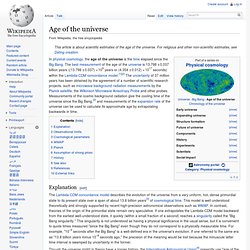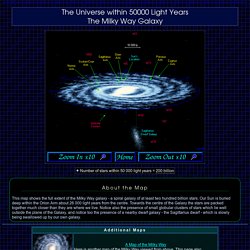

UFO General.
Constellations. Galaxies. Age of the universe. Explanation[edit] The Lambda-CDM concordance model describes the evolution of the universe from a very uniform, hot, dense primordial state to its present state over a span of about 13.8 billion years[3] of cosmological time.

This model is well understood theoretically and strongly supported by recent high-precision astronomical observations such as WMAP. Timeline of the universe. Using observatories on the earth and in space, astronomers have been able to study the nature of the cosmos in unprecedented detail.

By analysing the motion of distant galaxies, they have discovered that the whole cosmos is expanding under the influence of forces unleashed at its birth in the big bang. Combined with studies of the radiation left over from that primordial explosion, they have found that the universe was born 13.7bn years ago, give or take 200m years. Pinning down the date of creation with such precision is impressive, but scientists have gone much further. The Universe within 50000 Light Years - The Milky Way Galaxy. About the Map.

Our Universe. The Big Bang. Arecibo message. This is the message with color added to highlight its separate parts.

The actual binary transmission carried no color information. The Arecibo message was broadcast into space a single time via frequency modulated radio waves at a ceremony to mark the remodeling of the Arecibo radio telescope in Puerto Rico on 16 November 1974.[1] It was aimed at the globular star cluster M13 some 25,000 light years away because M13 was a large and close collection of stars that was available in the sky at the time and place of the ceremony.[2] The message consisted of 1,679 binary digits, approximately 210 bytes, transmitted at a frequency of 2,380 MHz and modulated by shifting the frequency by 10 Hz, with a power of 1,000 kW. The "ones" and "zeros" were transmitted by frequency shifting at the rate of 10 bits per second. The total broadcast was less than three minutes.[1][3] Dr.
Explanation[edit] Numbers[edit] DNA elements[edit] Multiverse. Star. For at least a portion of its life, a star shines due to thermonuclear fusion of hydrogen into helium in its core, releasing energy that traverses the star's interior and then radiates into outer space.

Once the hydrogen in the core of a star is nearly exhausted, almost all naturally occurring elements heavier than helium are created by stellar nucleosynthesis during the star's lifetime and, for some stars, by supernova nucleosynthesis when it explodes. Near the end of its life, a star can also contain degenerate matter. Astronomers can determine the mass, age, metallicity (chemical composition), and many other properties of a star by observing its motion through space, luminosity, and spectrum respectively. Sun. Aurora (astronomy) Images of the aurora australis and aurora borealis from around the world, including those with rarer red and blue lights Overview[edit] Auroras are classified as diffuse and discrete.

Sun dog. Sun dog at Stonehenge Sun dogs in Hesse, August 12, 2012 Sundogs may appear as a colored patch of light to the left or right of the sun, 22° distant and at the same distance above the horizon as the sun, and in ice halos.

They can be seen anywhere in the world during any season, but they are not always obvious or bright. Sundogs are best seen and are most conspicuous when the sun is low. Halo seen in summer, India --- Kolkata Etymology[edit] Interplanetary dust cloud. The interplanetary dust cloud is cosmic dust (small particles floating in space) which pervades the space between planets in the Solar System and in other planetary systems.

It has been studied for many years in order to understand its nature, origin, and relationship to larger bodies. Sources of interplanetary dust[edit] The sources of interplanetary dust particles (IDPs) include at least: asteroid collisions, cometary activity and collisions in the inner solar system, Kuiper Belt collisions, and interstellar medium grains (Backman, D., 1997). Micrometeoroid. Micrometeorite, collected from the Antarctic snow, was a micrometeoroid before it entered the Earth's atmosphere A micrometeoroid is a tiny meteoroid; a small particle of rock in space, usually weighing less than a gram.

A micrometeorite is such a particle that survives passage through the Earth's atmosphere and reaches the Earth's surface. Scientific interest[edit]
Black hole. A black hole is defined as a region of spacetime from which gravity prevents anything, including light, from escaping.[1] The theory of general relativity predicts that a sufficiently compact mass will deform spacetime to form a black hole.[2] Around a black hole, there is a mathematically defined surface called an event horizon that marks the point of no return.

The hole is called "black" because it absorbs all the light that hits the horizon, reflecting nothing, just like a perfect black body in thermodynamics.[3][4] Quantum field theory in curved spacetime predicts that event horizons emit radiation like a black body with a finite temperature. This temperature is inversely proportional to the mass of the black hole, making it difficult to observe this radiation for black holes of stellar mass or greater.
Objects whose gravity fields are too strong for light to escape were first considered in the 18th century by John Michell and Pierre-Simon Laplace. History General relativity. Supermassive black hole. A gas cloud with several times the mass of the Earth is accelerating towards a supermassive black hole at the centre of the Milky Way. Top: artist's conception of a supermassive black hole tearing apart a star. Bottom: images believed to show a supermassive black hole devouring a star in galaxy RX J1242-11. Left: X-ray image, Right: optical image.[1] Sagittarius A* Sgr A* was discovered on February 13 and 15, 1974, by astronomers Bruce Balick and Robert Brown using the baseline interferometer of the National Radio Astronomy Observatory.[10] The name Sgr A* was coined by Brown because the radio source was "exciting," and excited states of atoms are denoted with asterisks.[11] The Milky Way's Hidden Black Hole. A giant x-ray flare from the heart of our galaxy¿recorded by the Chandra X-ray Observatory last year¿has brought astronomers closer than ever to a black hole that most believe lurks there.
"This discovery takes us to the extreme," says Fulvio Melia, an x-ray astronomer at the University of Arizona. The brilliant burst came from only light-minutes away from the black hole's surface, Melia and others claim. Although researchers are still speculating about the cause of the flare, they have already used it to test several theories about the black hole and to put new limits on its size. Since the late 1970s, astronomers have kept watch on an object at the Milky Way's core known as Sagittarius A-star.
When viewed through a radio telescope, Sagittarius A-star appears so bright that many believe only a black hole's gravity could fuel it. The Scale of the Universe.